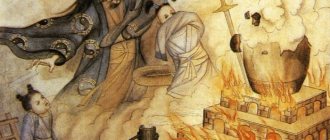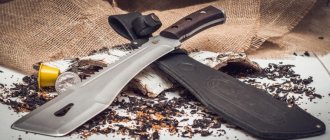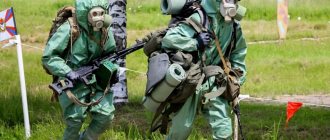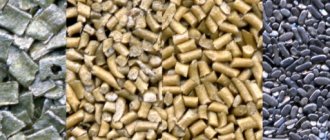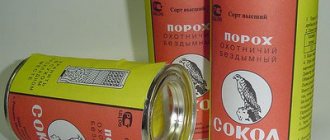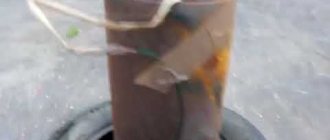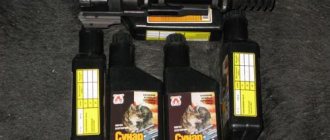- May 26, 2019
- Weapons and ammunition
- Ivan Gresko
According to experts, the effectiveness of hunting directly depends on both shooting skills and the quality of the ammunition used. Those who are planning to take self-loaded cartridges with them when fishing should wisely select hunting powder for them. On the modern arms market it is presented in a large assortment. Despite the fact that the intended purpose of each brand is common, the characteristics of hunting powder may be different. It's not surprising that a newbie can get confused. An overview of hunting powder varieties is contained in this article.
Acquaintance
Previously, hunting enthusiasts had only black powder at their disposal. As a result of firing such cartridges, a very strong roar was obtained, and a large amount of fire and smoke was generated. This had a negative impact on the condition of the trunks. As a result, hunters often had to clean them of carbon deposits. Judging by the reviews, it was impossible to do this without special alkaline solutions. Some craftsmen used washing powder for cleaning, namely, they poured the solution into the barrel and left it there for a while. The situation has improved significantly with the advent of smokeless varieties, which will be discussed later.
Review of advantages and disadvantages
The advantages of black powder include the following qualities:
- possibility of long-term storage with full preservation of functionality;
- ease of ignition even with a weak primer;
- the quality of the cartridge is almost not determined by the wads used, rolling and charging density;
- low sensitivity to ambient temperature;
- acceptable cost.
Disadvantages of smoky compositions:
- high hygroscopicity, as soon as the humidity exceeds the 2 percent threshold, there will be problems with ignition;
- provoke the development of corrosion processes in weapon barrels, since combustion products are sulfurous acid and sulfur;
- there is a lot of smoke after the shot, which reduces the possibility of rapid aimed shooting;
- impossibility of use in semi-automatic weapons;
- flammability (low ignition temperature threshold; if a significant amount burns, there will be a strong explosion);
- low power (approximately three times lower than that of smokeless compositions) does not allow for adequate shot flight speed;
- significant recoil and loud shot.
Advantages of smokeless powder:
- slight hygroscopicity (the damp composition can be dried, and all properties will be restored);
- high power;
- there are few combustion products, resulting in less barrel clogging;
- suitable for use in semi-automatic machines;
- no heavy smoke, less noisy shot.
The disadvantages of smokeless formulations include the following characteristics:
- high combustion temperatures provoke faster wear of the weapon barrel;
- the need for strict adherence to storage rules;
- shelf life is shorter compared to smoky formulations;
- instability to temperature changes.
"Sunar"
It is a fast-burning variety. Due to the fact that it has more complete energy capabilities, during the weighing process, experts recommend taking less Sunar gunpowder. This variety, compared to others, is more powerful. In addition, if we compare this brand with Sokol gunpowder, then Sunar is denser. The dispersion of the sample does not exceed 0.05 g. Due to the fact that special scales are needed when loading cartridges, many hunters may have difficulties in this matter. Judging by numerous reviews, this gunpowder burns in the barrel channel. For this reason, the sound of the shot is relatively quiet, there is no recoil, and the flame is practically not knocked out of the barrel. According to experienced hunters, a shot can be considered high-quality if at night the length of the knocked-out flame does not exceed 150 mm. During the day it should not be visible at all. Gunpowder "Sunar" is produced in Tambov. It is based on pyroxylin components. According to the owners, with such products it is possible to equip cartridges for smoothbore and hunting rifles. On average, the pressure is in the range of 630-680 bar. The fired projectile flies at a speed of 320 m/s.
"Greek Fire": Byzantine Gunpowder
According to historical sources, the recipe for gunpowder came from the Arabs to Byzantium. Local alchemists did a little work on the composition and began to use a flammable mixture called “Greek fire”. It showed itself successfully during the defense of the city, when fire from the pipes burned almost the entire enemy fleet.
It is not known for certain what was included in the “Greek fire”. His recipe was kept in the strictest confidence, but scientists suggest that the Byzantines used sulfur, oil, saltpeter, resin and oils.
About equipment
This brand is very dependent on the components of the ammunition. If they are combined unsuccessfully, for example, the hunter used hard “Zhevelo-M”, then during the shot the pressure inside the cartridge case will rise, resulting in an increase in recoil. In this case, the scree will have low accuracy. A similar effect is observed with rigid container wads embedded in the shape of an asterisk. It is more advisable to use soft felt wads “Zhevelo-N”, rolled by twisting. Thus, replacing primers will affect the pressure inside the barrel channel, and therefore the accuracy of the fire. The pressure indicator increases to 250 kg/cm2.
About fast-burning gunpowder
Judging by numerous consumer reviews, this variety is the leader in the rating of gunpowder for hunting cartridges. To make it burn faster, the manufacturer increased the porosity of the grains and additionally added nitroglycerin (20%) to its composition. The fast-burning Sunar is mainly used in skeet shooting training. It is used with shot charges, the weight of which varies from 24 to 28 g. According to experts, this variety is of little use for hunting. These products are marked SVS and SV.
Gunpowder leaves China: Arabs and Mongols begin to make gunpowder
Around the thirteenth century, the recipe for gunpowder fell into the hands of the Arabs and Mongols. According to one legend, the Arabs stole a treatise that contained a detailed description of the proportions of coal, sulfur and saltpeter necessary for the ideal mixture. In order to obtain this precious source of information, the Arabs destroyed an entire mountain monastery.
It is not known whether this was so, but already in the same century the Arabs designed the first cannon with gunpowder shells. It was quite imperfect and often maimed the soldiers themselves, but the effect of the weapon clearly covered the human losses.
About gunpowder with an average burning rate
Unlike products of the previous category, this gunpowder has optimal characteristics, namely, it burns much more slowly. The manufacturer puts the letter designations on its product - N and SF. Designed for loading shotgun ammunition up to 36g. Judging by the reviews, cartridges loaded with this gunpowder have a soft and smooth action. If shooting is done in winter or there is high humidity in the air, then the gas pressure will decrease by an average of 30%, and therefore the initial speed by 15%.
How is ammunition loaded?
In hunting rifles of caliber No. 12, “Sunar-32” with a load of 1.9 g is used for a charge weighing 32 g. “Sunar-35” is used in cartridges with a load of 2.1 g with a charge of 35 g. For the brand “Sunar-42” » 2.1 g of charge will require 42 g. In 16-caliber rifle units, these figures are somewhat different. For example, for a cartridge with a 1.7 g charge, 30 g is provided. If the Sunar-42 load is 2.1 g, then you need to take 32 g. In 20-caliber hunting rifles, cartridges equipped with Sunar-35 are used and 42". In the first case, the weight of the charge should not exceed 35 g, in the second - 28 g.
Gunpowder "Bars"
This product is in second place in the ranking and is intended for shotguns of 20, 16 and 12 gauges. It is smokeless powder. The grains have a spherical shape, due to which they occupy less volume when equipped. Gunpowder is made from nitroglycerin. Compared to pyroxylin analogs, fewer gases are released when it burns. If we compare it with Sokol gunpowder, then this variety is almost twice as dense. Due to the non-standard density, it is inconvenient to use measuring containers when equipping. If “Bars” is used in guns below 12 gauge, then the rifle unit will become unusable. Due to the fact that the composition of this grade is represented by a nitroglycerin mixture, during combustion a higher temperature is formed than in pyroxylin powders. For this reason, Bars reduces the service life of guns.
Creation
There is no documented document about who and when first invented gunpowder, that is, mixed saltpeter, coal and sulfur. Legends and stories are told in different versions, but they all have one thing in common. The inventors of gunpowder were alchemists, the predecessors of modern scientists. Ancient scientists compensated for their lack of knowledge with remarkable energy in conducting experiments and faith in their abilities.
The cherished dream of any alchemist was the production of a substance that gave eternal youth and was capable of turning any metal into gold. Unfortunately, it didn't work out. But by mixing a variety of ingredients, they received the first ideas about the nature of things and the first simple chemical compositions. One of the compounds once burned the alchemist's eyebrows. According to one version, this is the learned sage Sun Sy-miao, who lived in the 7th century BC.
Whoever the creator of gunpowder was, his invention did not at first cause much excitement among military officials. The magical exploding powder was of more interest to the court organizers of holidays, who used it for fireworks.
Only in the 11th century AD, miracle powder began to be used as a combat filling for “Fire Arrows,” the prototype of modern missiles.
A hit by such a projectile into a crowd of lightly armored or unarmored enemy soldiers would cause terrible consequences. True, this weapon was not very accurate; well, if one out of a dozen hit the target, the use was rather demoralizing.
Gunpowder came to Europe, according to most researchers, along with Arab merchants along the Great Silk Road. There is a legend about the monk Berthold Schwarz, who accidentally obtained gunpowder in the 14th century. This story, upon closer examination, does not stand up to scrutiny. One has only to say that by this time the components of gunpowder were known, the matter was behind the invention of a weapon with the help of which gunpowder would throw projectiles.
The first prototypes of cannons, used on the battlefields of Europe, marked a revolution not only in military affairs, but also in all related fields. Gunpowder spurred the industry, because to fire a shot you need a barrel made of high-quality metal. The storage of gunpowder caused problems and packaging development was required.
The nitrate contained in the composition, a hygroscopic material that absorbs moisture from the environment, quickly became unusable. Gunpowder quickly became damp if stored improperly.
At the same time, gunpowder made almost any armor useless, depriving armor masters of work. Medicine has come a long way, as bullet wounds and burns are treated differently than stab wounds. By the way, representatives of medicine have repeatedly raised the issue of banning gunpowder as “a hellish potion that does not discriminate between rich and poor, commanders and recruits.” And that was just the beginning.
Gunpowder was also used against stone.
High castle walls became a thing of the past with the spread of cannons; already in the 15th century, defensive architecture tended towards thick, low walls. Engineers strive to dig in, create more bastions, aproshes and trenches. In order to undermine these walls, they use mines, and barrels of gunpowder are placed in them. This is how Kazan was taken by the troops of Ivan the Terrible.
Such devices were called mines, and often the besieged made counter-mines, destroying detachments of enemy sappers. The defending soldiers also laid mines. In this case, the entire advanced detachment of the attackers often died, and the soldiers behind them often did not have the courage to pass through the gap, in which several dozen comrades died in a second.
Since the beginning of the use of the composition in war, the problem of cleaning powder deposits has become the cornerstone. From the Middle Ages to the present day, this point has not changed. The barrel of even a modern sniper rifle, if not cleaned by a careless or lazy shooter, breaks, just as it did hundreds of years ago.
Of course, with the use of new types of gunpowder, cleaning the barrel has become less of an issue, but any self-respecting gun owner knows the “shoot and clean” rule. By the way, during the era of the Napoleonic Wars there was a method for expressly cleaning the barrel from carbon deposits during battle. To do this, it was enough to urinate into the trunk.
What do experienced hunters recommend?
For beginners who purchased Bars and decided to load the cartridges themselves, experts recommend starting with zeroing with minimal charges. For example, it is better to load 12-gauge shotguns with ammunition with a powder charge of 2.1 g. For 16-gauge, 1.7-gram charges are suitable. In a 20-caliber hunting rifle, it is advisable to reduce the powder weight to 1.4 g. After the cartridge case is equipped with a powder charge, a 3-mm cardboard wad spacer should be placed on top. To prevent strong pressure from forming inside the barrel channel as a result of the shot, the wad should not be pressed too hard against the powder charge. Before seating it, experienced shooters thoroughly shake the cartridge case. To do this, it will be enough to lightly tap on it with your fingernail.
"Falcon"
This variety is considered the oldest Russian smokeless powder. In the ranking in third position. Hunters have been using it since 1937. According to experts, the Falcon is suitable for a wide variety of shooting units. The exception is hunting rifles with fixed barrels. The grains are rectangular in shape. Hunting powder is produced based on nitrocellulose. This brand of gunpowder has a stable chemical composition and is not prone to sticking. Especially for this purpose, the manufacturer subjects the powder plates to graphitization procedures. In addition, this procedure prevents electrification of particles. The 1.3 cm thick plates can have different lengths. On average, it varies between 1.2-1.7 mm. “Falcon” is presented in two varieties: highest and first. Sold in cans of 250 g. Gunpowder is also placed in galvanized boxes weighing 50 kg. Judging by the reviews, products can be stored in a jar for up to 6 years, in a box - up to 25.
Gunpowder on the pages of books and movies
Of course, such an important invention could not but leave a mark on culture. However, it is difficult to find a work in which special attention is paid to black powder, or the discovery of black powder. In fact, we don’t think when we see a wheel in a movie or book? Many popular sayings also refer to this substance.
Where did it come from to keep gunpowder dry? If the gunpowder is wet, the fighter is not ready to repel the attack. The legendary “Is there gunpowder in the flasks,” meaning the presence or absence of strength to continue the fight.
Meanwhile, there are several works that describe in detail operations with gunpowder. To get a better acquaintance with the manufacturing processes, it is worth turning to materials telling about people lost in uninhabited areas. As a rule, they all try, with varying degrees of success, to obtain gunpowder on their own.
Much attention is paid to gunpowder in English literature describing the era of the Napoleonic Wars. Thus, in the series of books about the adventures of Gunner Sharpe, each volume contains at least one detailed mention of loading the Brown Bess musket and a nod to English gunpowder.
In the television series based on the books, quite a lot of attention is also paid to gunpowder.
Gunpowder appears frequently in the book series about Royal Navy Captain Jack Aubrey by Patrick O'Brien. Much of the technical side is devoted to the sailing fleet, but a lot of attention is also paid to artillery training.
Descriptions of gunpowder can be found in unexpected works. The lion's share of authors ignore this composition, taking it for granted, but between the lines you can read about this, of course, one of the most important inventions of mankind.
The name has penetrated into our lives, and we can calmly enjoy green gunpowder tea, listen to Masha Gunpowder, without thinking about what the listed everyday phenomena are named after, and not smell gunpowder from the battlefields that took place over the centuries.
Products from Nobel Sport
Relatively recently, the French company Nobel Sport began producing Drago (Vectan) hunting powder for smoothbore gun owners. Designed for loading 12/70 ammunition. Used with Cheddite (CX2000) capsules. With a shot load of 32 to 34 g, the cartridge must contain a powder charge weighing from 1.58 to 1.63 g. Experts advise using Drago with 12N22 container wads. The loaded cartridge has a length of 5.8 cm. Gunpowder is supplied to the market in packages weighing 500 g. To become the owner of this product, you will have to shell out 1,200 rubles.
"Irbis"
This variety is produced by employees of the Kazan State Powder Plant. The line is represented by the Irbis brands No. 24, 32 and 35. There is also the Irbis-M brand, which, according to experts, they began to create specifically for use at sub-zero temperatures. Today this brand is practically not found. Those who decide to independently load a cartridge with Irbis gunpowder should put 1.7 g of gunpowder and 35 g of shot into the case. In this case, you need to use a wad container, and at the end the case itself is rolled using the star method. A fired lead projectile covers a distance of 380 m per second.
"Firework"
According to experts, the gunpowder plant in the city of Tambov also produces the Salyut line. However, compared to “Sunar”, this variety has slightly worse characteristics. When equipping, it is of great importance which components to use. At this stage, the master needs to be as careful as possible. For Salyut brand gunpowder, it is better to use the KV-21 and Zhevelo primer igniters. If the cartridge is properly equipped, then ignition and reliable combustion will be ensured. In order for increased pressure to form inside the liner, they need to be wadded with soft, but at the same time quite elastic products.
Gunpowder: First military use by the Chinese
Europeans had long believed that the Chinese did not use gunpowder for military purposes. But in fact, these data are erroneous. There is written evidence that back in the third century, one of the famous Chinese commanders managed to defeat nomadic tribes with the help of gunpowder. He lured the enemies into a narrow gorge where charges had previously been planted. They were narrow clay pots filled with gunpowder and metal. Bamboo tubes with cords soaked in sulfur led to them. When the Chinese set them on fire, thunder struck, reflected several times by the walls of the gorge. Clods of earth, stones and metal pieces flew from under the nomads' feet. The terrible incident forced the aggressors to leave the border provinces of China for a long time.
From the eleventh to the thirteenth centuries, the Chinese improved their military capabilities with the use of gunpowder. They invented new types of weapons. Enemies were overtaken by fireballs, projectiles launched from bamboo tubes, and guns launched from catapults. Thanks to their “fire potion,” the Chinese emerged victorious in almost all battles, and the fame of the unusual substance spread throughout the world.
Experts' opinion
Today, there is a debate surrounding hunting powder brands regarding their ease of use and quality. Judging by numerous consumer reviews, we can conclude that the Sunar is more convenient for horizontal shooting. Those who decide to acquire the Sokol brand are advised to pay attention to the shape of the grains. They must be plate-like. This was undertaken by the manufacturer specifically to ensure better combustion of gunpowder. This grade is undesirable for rifle units with gas exhaust mechanisms. The fact is that such a gun will very quickly become clogged with unburnt particles from the Falcon, as a result of which the weapon will have difficulty reloading. "Leopard", according to hunters, is quite good, since it provides a small return. In addition, as a result of its combustion, almost no fire or smoke is generated.
What are different types of gunpowder made from?
The first examples of black powder were made from sulfur, saltpeter and honey with realgar, that is, arsenic monosulfide. Sometimes dried roots and other plants were used. But the mixture achieved the greatest effect when mixing sulfur, saltpeter and coal. This is how classic black powder was born. The percentage of substances during mixing played an important role. This was due to the characteristics of the substances themselves, since:
- sulfur, ignites at a temperature of only 200 degrees Celsius, in the classic recipe it is 10%;
- saltpeter, picks up the fire and releases oxygen necessary for the combustion of the next element, it should be 75%;
- coal, which provides gas release and energy pushing the projectile, 15% of the substance is enough.
Black powder may contain other proportions, but in these cases the ballistic characteristics can differ significantly, both up and down.
Too powerful gunpowder was also not needed by the troops.
The imperfection of the weapon when using strong powder led to rapid wear of the barrel. The production of gunpowder was usually organized in sparsely populated parts of the city, not far from the river, on which water mills were installed to grind the composition.
Sometimes you can find fragments of the old craft in city names, for example, in Nizhny Novgorod there is a Zelensky Congress. In the old days, gunpowder was called a potion, and at the bottom of the ravine through which the road was built, gunpowder was produced for the defense of the Nizhny Novgorod Kremlin.
It is important to understand the difference between simply burning gunpowder and detonating it to explode. In an open space, gunpowder is a specific flammable composition with a high burning rate and heat generated, but not explosive. Burning gunpowder in a casing is a different matter. The released gases and smoke create pressure, which leads, in one case, to an explosion, in another, if the conditions are right, to a shot.
The restless military, in search of the ideal weapon, from the very beginning complained about the main drawback of black powder, in fact, the smoke itself. When fired, the gun or fighter was covered in clouds of smoke; with little wind, they did not dissipate for a long time. This unmasked the position, while at the same time making it difficult to aim.
The Russian language has preserved the saying “The battle is in the Crimea, everything is in smoke...” with different, more or less decent endings.
Chemists decided to help the army, and in the 19th century, first in one, then in another, third, fifth country, samples of pyroxylin gunpowder began to appear. In Russia, the composition of this gunpowder was calculated by Mendeleev himself. According to legend, for this he only needed a list of wagons with raw materials entering the territory of the German gunpowder factory.
It took some time to make the sample more stable, but the discovery was made and it could not be stopped. This was another revolution, since a new type of gunpowder, which had much greater power, pushed forward not only bullets, but also industry and military affairs. World wars and modern conflicts already use it.
Despite the virtual conquest of smokeless gunpowder world domination, black powder continues to enjoy wide popularity among the general population. It is used for fireworks, hunting rifles, various “male” toys such as crossbows, which often touch the fingers of players.
You can buy black powder in a store, but you can try making it yourself. Step-by-step recipes are widely available in a variety of book and electronic resources. In any case, you need to remember the safety of both yourself and those around you.
In addition to the types of gunpowder presented, exotic options appear. For example, liquid gunpowder, which contains kerosene. A crazy idea at first glance, in tests it gave fantastic results in terms of armor penetration.
Much information is still classified as “secret”, but technical minds continue to develop this topic.
Quite often, kerosene is used as the main component in land mines (from the Latin focus - fire) and napalm (napalm - from the English naphthenic acid - naphthenic acid), but this is a slightly different story.

